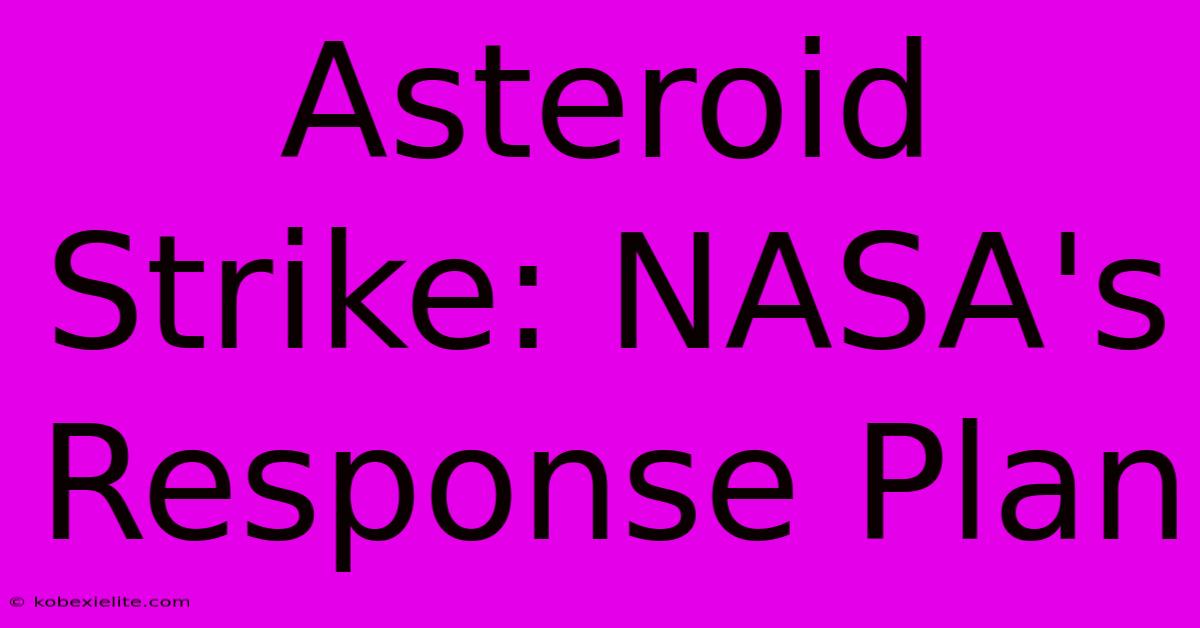Asteroid Strike: NASA's Response Plan

Discover more detailed and exciting information on our website. Click the link below to start your adventure: Visit Best Website mr.cleine.com. Don't miss out!
Table of Contents
Asteroid Strike: NASA's Response Plan – Are We Ready?
The possibility of a large asteroid impacting Earth is a real, albeit low-probability, threat. While Hollywood often depicts catastrophic scenarios, NASA and other space agencies are actively working on strategies to mitigate this risk. This article delves into NASA's current response plan to an asteroid threat, exploring both the detection and deflection strategies employed.
Detecting the Threat: Eyes on the Sky
The first step in any defense strategy is detection. NASA's Planetary Defense Coordination Office (PDCO) plays a crucial role in this. Their primary mission is to identify, track, and characterize potentially hazardous objects (PHOs) – asteroids and comets that could pose a risk to Earth.
Key Detection Methods:
- Telescopic Surveys: Numerous ground-based and space-based telescopes constantly scan the skies, searching for moving objects. These surveys are constantly improving in sensitivity and coverage, allowing for earlier detection of even smaller asteroids.
- Data Analysis: Sophisticated software analyzes the vast amount of data collected by these telescopes, identifying potential PHOs and calculating their orbits to predict future trajectories.
- International Collaboration: The PDCO works closely with international partners, sharing data and coordinating efforts to ensure global coverage and minimize duplication of effort. This collaboration is critical for effective monitoring.
Deflecting an Asteroid: Our Planetary Defense Strategies
If an asteroid is identified as a potential threat, the next phase involves developing and implementing a deflection strategy. The approach depends heavily on the asteroid's size, composition, and the time available before a potential impact.
Deflection Techniques:
- Kinetic Impactor: This involves launching a spacecraft to collide with the asteroid at high speed, subtly altering its trajectory. NASA's DART (Double Asteroid Redirection Test) mission successfully demonstrated this technique in 2022. This is currently the most mature and viable deflection technology.
- Gravity Tractor: A spacecraft would fly alongside the asteroid for an extended period, using its gravitational pull to gradually nudge the asteroid off course. This method requires more time but offers a more gentle and potentially more controlled deflection.
- Nuclear Option: While often portrayed in science fiction, a nuclear explosion near an asteroid could be used as a last resort for very large, fast-approaching asteroids. The explosion wouldn't necessarily destroy the asteroid, but rather break it into smaller, less dangerous pieces, or significantly alter its trajectory. This is a complex strategy requiring careful consideration and international cooperation.
NASA's Response Plan in Action: A Coordinated Effort
NASA's response to a potential asteroid impact wouldn't be a solitary endeavor. It involves a complex interplay of various agencies, scientists, and international collaborators. The plan incorporates:
- Early Warning System: The PDCO continuously monitors for potential threats, providing early warnings to governments and the public.
- International Coordination: Collaboration with international partners is essential for sharing data, resources, and coordinating deflection strategies.
- Public Communication: Effective communication with the public is critical to maintaining transparency and managing potential panic.
- Emergency Response Planning: Contingency plans are developed to address potential impacts and mitigate damage, involving various government agencies and disaster relief organizations.
The Future of Planetary Defense
While the chances of a catastrophic asteroid impact are relatively small, the potential consequences are immense. NASA's ongoing efforts in asteroid detection and deflection represent a significant investment in planetary protection. Continued research and development of new technologies, coupled with strong international collaboration, are vital in enhancing our ability to protect Earth from future asteroid threats. The future of planetary defense relies on ongoing vigilance, technological innovation, and a commitment to global cooperation.
Keywords:
Asteroid strike, NASA, Planetary Defense Coordination Office (PDCO), Potentially Hazardous Objects (PHOs), Asteroid deflection, Kinetic Impactor, Gravity Tractor, Nuclear option, DART mission, Planetary defense, Space exploration, Asteroid detection, International collaboration, Emergency response, Space safety.

Thank you for visiting our website wich cover about Asteroid Strike: NASA's Response Plan. We hope the information provided has been useful to you. Feel free to contact us if you have any questions or need further assistance. See you next time and dont miss to bookmark.
Featured Posts
-
Hammer Denies Cannibalism Claims
Feb 13, 2025
-
Marvels Brave New World A Mixed Bag
Feb 13, 2025
-
Devonte Aransibia Remembering Tonbridge Angels Star
Feb 13, 2025
-
Assault Accusation Against Ex Fiance
Feb 13, 2025
-
Champions League Bayern Wins First Leg
Feb 13, 2025
